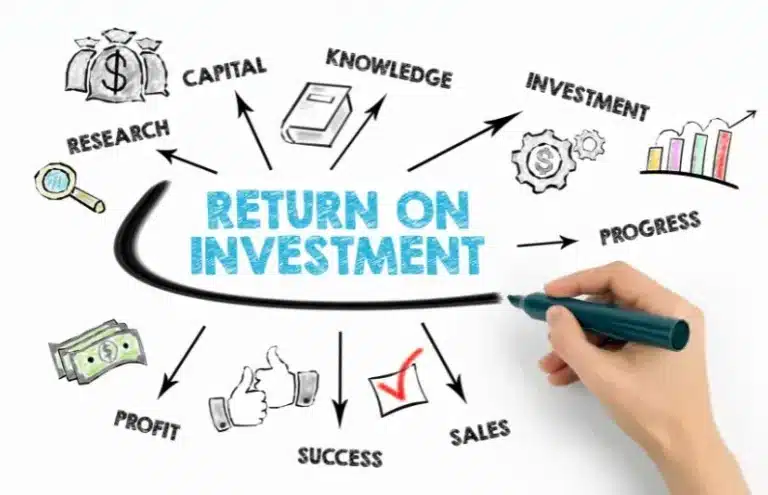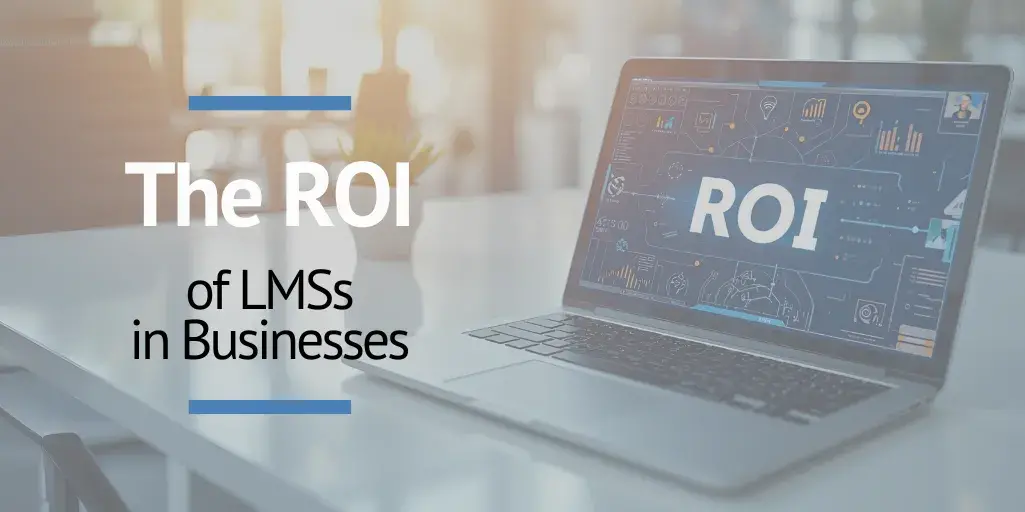The ROI of LMSs in businesses is the metric that allows us to measure the impact of implementing an elearning system for training staff, leaders, and various stakeholders.
Put simply, it refers to those KPIs that reveal the actual profitability of investing in digital learning. This is highly valuable information, as it enables training and HR managers to justify that such a significant investment translates into tangible benefits.
Knowing how to measure ROI in elearning is not always straightforward, as it requires going beyond traditional metrics such as learner satisfaction or course completion rates.
Whereas in academic environments the impact of an LMS is usually measured in terms of learning outcomes or performance, in the corporate world the conversation is different. Here, what really matters is the financial impact of corporate LMSs—their ability to improve processes, reduce costs, retain talent, and support strategic objectives.
The Business Online Training ROI therefore becomes the shared language between CFOs, IT managers, and HR leaders—each with their own perspective but with a common goal: ensuring that every pound invested in training generates a visible return.
If a company implements a learning management system and manages to reduce the onboarding time of new employees from six months to three, the impact on productivity is immediate. If a sales team improves its conversion rate thanks to well-designed digital training, the benefit shows up in quarterly figures. And if an organisation avoids sanctions thanks to compliance programmes delivered via an LMS, the financial saving is as real as any additional revenue.
Being able to accurately measure the Return on Investment in LMS Platforms is, therefore, what enables a training platform to become a strategic business tool.
But how does the analysis of Corporate LMS ROI differ from academic evaluation? What myths surround it? What factors determine it? And most importantly, How to Demonstrate LMS ROI using data, metrics, and industry-specific examples?
Is an LMS just another training expense, or a strategic investment that directly impacts productivity and performance?
Let’s find out.
Why Is It Crucial to Measure LMS ROI in Businesses?

Measuring the ROI of a training program through an LMS is essential to understand whether the platform has a real impact on productivity and business results. It enables training and HR leaders to assess the true profitability of learning programmes on overall company performance, justify their initiatives, and refine future strategy.
Talking about corporate learning without considering return is like planning a journey without a map or compass. In today’s organisations, every decision must be backed by clear data and measurable impact.
HR directors, training managers, and CFOs face the same recurring question: what exactly do we gain from investing in an LMS? Measuring the Corporate LMS ROI is necessary for digital learning to be seen not as a cost but as a driver of competitiveness.
The financial impact of corporate LMSs goes far beyond reducing travel expenses or in-person training logistics. It includes the productivity gained through shorter onboarding processes, improved sales through continuous training, and the prevention of regulatory penalties. By establishing quantifiable performance indicators, an LMS is evaluated not by how many people use it but by how much it contributes to strategic business goals.
So, what sets the calculation of enterprise LMS ROI in a corporate context apart from academic settings? The key lies in the metrics.
At university, the effectiveness of an LMS is measured by completion rates, grades, or learner satisfaction. In contrast, in the corporate world, it’s about cost reduction, onboarding time, fewer errors, productivity improvement, or revenue growth.
Put simply, in education the ROI speaks of learning; in business, it speaks of results.
In this sense, an enterprise LMS becomes a bridge between training needs and financial results. It’s about proving that the elearning platform is part of a strategy that enables companies to grow and remain competitive. Those who rigorously measure the Return on Investment in LMS Platforms place training at the heart of decision-making, proving that investing in knowledge means investing in profitability.
Myths and Realities About ROI in Corporate Training

It’s very common that when the concept of ROI applied to digital training is brought up within a company, doubts and objections arise. Many of these are repeated so often that they’ve turned into widespread myths.
Debunking them is essential for training managers to demonstrate the value of an LMS with data and overcome the scepticism that sometimes surrounds investment in training initiatives.
Myth: The ROI of Training Cannot Be Measured
One of the most widespread myths is that ROI cannot be measured in training. There’s a common belief that learning is too intangible to be translated into numbers.
However, by simply observing its impact on critical processes such as onboarding or compliance, it becomes clear that there are measurable indicators.
For instance, if the adjustment period for a new employee drops from six to four months thanks to a structured digital programme, the productivity gain is perfectly quantifiable—and forms part of the Corporate LMS KPIs.
Myth: An LMS Only Helps Reduce Training Costs
Another frequent myth is that an LMS is only useful for reducing costs. While it’s true that savings on logistics and travel are among the most obvious financial benefits of corporate LMS platforms, the true return goes far beyond that.
The LMS ROI for Businesses Online is also measured through improved sales, fewer operational errors, better talent retention, and alignment with strategic objectives.
Reducing it to mere cost savings is to overlook the strategic dimension it can offer to an organisation.
Myth: Return on Investment Takes Too Long to Show
There’s also a common belief that ROI takes too long to materialise. In reality, some results can be seen in the short term.
For example, the financial impact of corporate LMSs is clear in faster onboarding processes or in meeting compliance requirements that help avoid immediate penalties.
Other benefits, such as improved retention or talent development, may require a medium-term view, but they are still measurable.
Ultimately, businesses that learn to separate myths from realities can grasp how to demonstrate LMS ROI with a strong and convincing foundation. The key lies in using Key LMS Metrics for Businesses that go beyond perception and translate into real business evidence. When the data speaks, myths fade—and the LMS is no longer seen as a support tool, but as a strategic investment.
Reality: There Are Financial Metrics to Measure ROI
The ROI of a training program in digital learning goes beyond qualitative perceptions. It can be directly linked to economic figures such as reduced turnover costs, savings in working hours, or increased sales following specific training programmes.
These metrics turn corporate training ROI into a credible metric with real weight in the company’s financial reports.
Reality: The Impact on Onboarding Is Immediate
The digitalisation of onboarding processes for new employees is one of the clearest examples of how to calculate LMS ROI in business.
A structured online training plan shortens the learning curve from the very first month, with a direct effect on productivity. The speed at which a professional becomes fully operational translates into a tangible and measurable benefit.
Reality: Sector-Specific Cases Show Concrete Results
Several industries already have clear evidence of the financial impact of corporate LMSs. In healthcare, for example, digital training in safety protocols reduces medical errors and associated costs. In retail, training in customer service and sales increases the average transaction value. In manufacturing, preventive training reduces workplace accidents and absences.
These cases prove that the Return on Investment in LMS Platforms applies across very different contexts—and is always quantifiable.
Reality: LMSs Enable Detailed Tracking with Effective KPIs
Modern platforms make it possible to capture data that was previously impossible to track. Today, it’s viable to measure in real time indicators such as participation, progress, module completion, and practical application.
These Key LMS Metrics for Businesses form the foundation for justifying investments and forecasting future results with a level of accuracy unheard of just a few years ago.
Reality: An LMS Strengthens Culture and Talent Retention
Beyond the numbers, a well-implemented LMS has the power to convey corporate values and build a culture that aligns with business strategy. While this effect may not always translate into immediate figures, it has a direct impact on employee retention and engagement.
By creating personalised learning paths and promoting continuous development, talent loyalty is reinforced—a key factor when measuring the ROI of a training program in the medium term.
Factors That Influence ROI in Corporate Environments

The factors that influence ROI in corporate or business settings aren’t limited to a single indicator—they reflect a combination of elements which, when working together, determine whether a training project becomes profitable or fails to deliver long-term value. Productivity, efficiency, talent retention, compliance, or even LMS integration with other corporate systems are all part of the same mechanism.
The calculation of ROI in corporate training is not an abstract exercise but the result of multiple variables that affect the company’s day-to-day operations.
An LMS directly impacts key processes, and each of these factors contributes to ROI in its own way.
Let’s explore the most relevant ones to understand how the LMS ROI for Businesses Online is built—and which key metrics help justify it with data.
Productivity and Efficiency: Reducing Time and Operational Errors
An LMS allows you to standardise processes and ensure that all employees receive the same information in the same format, which reduces variability and operational errors.
In an industrial environment, for instance, training workers on the proper use of machinery helps reduce downtime and costs caused by mistakes, while also preventing potential risks and workplace accidents.
The financial impact of corporate LMSs becomes clear when fewer errors lead to less wasted resources and greater efficiency throughout the value chain.
Talent Retention and Development: Retention and Motivation
Companies that invest in professional development increase their ability to retain talent.
The Return on Investment in LMS Platforms is seen here in reduced staff turnover, which leads to significant savings in recruitment and training of new hires.
Moreover, offering personalised digital learning paths boosts motivation and engagement—factors that directly influence productivity and shape organisational culture.
Faster, More Effective Onboarding
The onboarding process is one of the most expensive for any organisation. Thanks to an LMS, new employees can access structured content from day one, significantly shortening the learning curve and helping them become autonomous more quickly.
A three-month reduction in onboarding time means three extra months of productivity for every new hire.
This is one of the clearest examples of how to demonstrate LMS ROI in businesses with immediate figures.
Regulatory Compliance: Avoiding Penalties and Legal Risks
In sectors such as healthcare, finance, or food, regulatory compliance is critical. A mistake in applying protocols can result in hefty fines or irreversible damage to a company’s reputation.
Using an LMS ensures that all employees have access to up-to-date information and comply with current regulations. In this way, the Corporate LMS ROI becomes evident in concrete outcomes like reduced legal risks and protection of brand value.
Reduced Logistics and In-Person Training Costs
Replacing large-scale face-to-face training with online programmes leads to immediate savings on travel, accommodation, venue hire, and downtime. Moreover, an LMS makes it possible to scale training to hundreds of employees without proportionally increasing costs.
This is one of the financial benefits of corporate LMS platforms that is easiest to demonstrate to finance leaders, as it translates into clear figures from the very beginning.
Integration with Corporate Systems (ERP, CRM, BI)
The true potential of an LMS emerges when it is integrated with other corporate platforms.
For example, connecting it to an ERP allows companies to analyse the impact of training on production indicators. Integrated with a CRM, the LMS makes it possible to measure the relationship between sales training and performance. With BI tools, learning data can be cross-referenced with business KPIs.
In this way, ROI becomes more than an estimate—it becomes an analysis backed by real evidence of how training drives overall performance.
Examples of LMS Impact in Businesses
Real-life cases offer the strongest proof that ROI is not just a theoretical concept businesses should aim to measure and improve—but rather a tangible outcome of implementing training strategies supported by technology.
Each sector has its specific characteristics, but they all share one common trait: when training is digitalised and measured, the impact is reflected in clear business results.
Santalucía Seguros: Immersive Onboarding with Virtual Reality
In the insurance sector, where talent retention and cultural alignment are critical, Santalucía implemented an immersive 360° onboarding experience to introduce new employees to the company’s values, facilities, and key processes from day one.
The results were clear: newly hired professionals reported feeling more prepared and connected to the organisation, with a stronger understanding of corporate values from the outset. Although exact data on reduced adaptation time has not been published, the company emphasises that the experience accelerated integration and improved early engagement.
The takeaway here is clear: investing in LMS-integrated technology—even through immersive formats—can generate direct returns in satisfaction, early retention, and reduced costs linked to in-person mentoring.
Grupo Elecnor: Prevention and Safety as a Profitable Investment
In the industrial sector, where workplace risks come with high costs, Elecnor stands as a prime example. With over 25,000 employees, the company delivered more than 736,800 hours of safety training in 2024, achieving over 600,000 participations through its “Control Your Risks” programme.
The impact was immediate: an accident rate of 2.0—one of the lowest recorded in the company’s recent history.
This figure not only reflects improved safety but also substantial savings on costs related to medical leave, insurance, penalties, and resource reorganisation. Here, the Return on Investment in LMS Platforms is directly linked to the company’s financial sustainability, showing that investing in prevention training is not a cost, but a strategy for efficiency and human capital care.
These examples clearly demonstrate that the financial impact of corporate LMSs spans across areas as varied as talent retention, revenue generation, or accident reduction.
The conclusion is clear: every sector finds in the LMS a strategic ally to connect learning with business outcomes—and in all cases, metrics provide the evidence needed to convince decision-makers.
How to Calculate LMS ROI in Business Step by Step

Calculating the return on investment in training begins with defining which results you want to influence—productivity, compliance, sales, or onboarding time. Next comes identifying direct and indirect costs, and finally expressing everything in pounds to compare it against the investment. If you’re wondering where to start, consider this simple equation: how much money stops leaving the business, and how much additional revenue comes in thanks to the LMS?
One critical factor is traceability. If you define from the outset which data to track (hours saved, incidents avoided, first-time resolution rates, sales per employee, penalties avoided…) and how to convert them into economic value, the calculation stops being subjective and becomes more representative of your company’s reality.
Lastly, decide on the time frame. The financial impact of corporate LMSs can be seen within weeks (onboarding and compliance) or may take a few months (retention and sustained productivity). Choosing an annual period and properly amortising one-off costs—such as implementation, integration, or initial content creation—will make your calculation more accurate and easier to compare.
The Formula for Calculating ROI in Corporate Training
When calculating the LMS ROI for Businesses Online, we can use the traditional ROI formula, provided that the appropriate cost and benefit components are selected.
ROI (%) = (Financial gains attributable to the LMS − Total LMS costs / Total LMS costs) * 100
- Benefits: savings and/or additional revenue directly attributable to the project (in pounds).
- Costs: licences, implementation, integration, content production, administration, support, and internal communications (in pounds, for the same period).
Metrics That Truly Drive ROI (And How to Convert Them to Pounds)
These are the most common levers and how they translate financially:
| Metric | Example | Conversion |
|---|---|---|
| Cost savings from in-person training | Travel, accommodation, room hire, trainer hours, and unproductive hours of attendees. | Total avoided expenses per session or per year. |
| Reduced onboarding time | Weeks it takes a new hire to become fully operational. | (Weeks saved × hours/week × hourly rate for the role). |
| Increase in sales or productivity | Improved conversion rate, average ticket size, first-time resolution rate, OEE, etc. | (Change in indicator × margin or unit value). |
| Improvement in compliance and safety KPIs | Fines avoided, fewer incidents, claims, legal and insurance costs. | (Historical or forecasted cost × % reduction after LMS implementation). |
When presenting these figures, label each lever clearly. It’s much easier to justify the financial benefits of corporate LMS platforms when each line item has a defined calculation method and an internal data source.
Practical Template for Corporate LMS KPIs
When we talk about KPIs for a corporate LMS, we’re not referring to a generic list of indicators, but rather to a simple framework that any company can replicate in a spreadsheet. The idea is to organise the information into four blocks that answer very specific questions:
- Annual LMS licence: data from IT or Procurement.
- Implementation and integration: if you've paid to set up the system or connect it to other platforms, this should be allocated as an annual expense (PM or IT).
- Content production: the cost of creating internal courses, hiring instructional designers, or licensing external content (L&D team).
- Administration and support: internal HR or IT resources dedicated to managing the platform.
- In-person training hours avoided: if you previously gathered 50 people in a room for 8 hours, and they now complete an online course in 4, you're saving 4 hours × 50 employees = 200 hours. Multiply those hours by the cost per hour of each employee to get an economic value.
- Reduced operational errors: for example, in a production plant, each error costs £500 in waste. If online training helps you reduce 20 errors per year, you've saved £10,000.
- Onboarding time: if a new employee takes 8 weeks to become productive and with the LMS it only takes 6, you’ve gained 2 weeks. Convert those hours into economic value (2 weeks × 40 hours × hourly rate for the role).
- First-year turnover: if you normally lose 10 employees within their first 12 months and each departure costs £8,000 in replacement, but with digital training you only lose 6, the saving is £32,000.
- Sales / productivity: a sales team receiving microlearning might improve its conversion rate by 5%. If that results in an additional £200,000 in revenue, that’s the benefit attributable to the LMS.
- Incidents or fines avoided: in regulated sectors, a single error could cost £50,000. If traceable training helps reduce this risk and avoid two fines per year, you’re saving £100,000.
| Category | KPI | How It’s Measured | Data Source | Conversion Example |
|---|---|---|---|---|
| LMS Costs | Total LMS cost | Sum of annual licence + implementation/integration (amortised) + content creation + support and admin | IT / Procurement / HR | €24,000 licence + €10,000 implementation + €20,000 content + €20,000 support = €74,000 |
| Operational Efficiency | In-person training hours avoided | No. of hours saved × no. of employees × cost/hour | L&D / HR | 200 h saved × €20/h = €4,000 |
| Operational Efficiency | Reduction in operational errors | No. of errors avoided × average cost per error | Operations / Quality | 20 fewer errors × €500/error = €10,000 |
| Talent and People | Average onboarding time | Weeks reduced × hours/week × hourly rate for the role | HR | 2 weeks × 40 h × €25/h × 120 employees = €240,000 |
| Talent and People | First-year turnover | No. of leavers avoided × replacement cost per employee | HR | 4 leavers avoided × €8,000 = €32,000 |
| Business and Compliance | Increase in sales / productivity | Change in indicator × unit margin | Sales / BI | 5% sales increase = €200,000 additional revenue |
| Business and Compliance | Incidents or fines avoided | Historical or expected cost × % reduction | Legal / Compliance | 2 fines avoided × €50,000 = €100,000 |
- In technical support: “tickets resolved on first contact”.
- In logistics: “incidents per 1,000 orders”.
- In retail: “sales per employee in-store”.
How to Calculate LMS ROI in Businesses: A Complete Step-by-Step Example
First, it’s important to calculate the actual implementation costs. The annual platform licence is €24,000, plus €10,000 for system integration (amortised over three years), €20,000 for the initial content production, €20,000 for administration resources (equivalent to half of a full-time role), and €6,000 for support and communications.
The total annual cost of the project is therefore €80,000.
From here, the benefits are calculated:
- Savings on in-person onboarding. Before the LMS, each onboarding cost over €1,100 in trainer hours, room rental, and manager time. With the digital system, this cost is reduced to €275 per hire, generating annual savings of over €100,000.
- Productivity time gained. The onboarding curve is shortened from eight to six weeks. This difference equals 80 hours of productive time gained per employee—worth €2,000 per hire. Over one year, this adds up to €240,000 in additional productivity.
- Compliance and risk. The company had a history of €30,000 in annual fines and rework. Thanks to traceable training, a 60% reduction is expected, resulting in savings of €18,000.
- Logistics costs avoided. Replacing in-person sessions with online formats saves around €20,000 in travel, room hire, and expenses.
- Sales productivity. Microlearning content used by the sales team frees up around 10,800 hours of unproductive time annually. At a conservative value of €20 per hour, this translates into €216,000 in additional benefit.
But beyond the number, what truly matters is how it’s presented to leadership. An executive summary that shows, in a single slide, the costs, benefits, net gain, and ROI—supported by methodological notes and a panel of quarterly KPIs—helps deliver the message with clarity and precision. At that point, corporate training stops being seen as a cost and becomes firmly established as a strategic investment with direct impact on business outcomes.
Key Financial and Non-Financial Indicators in Corporate Training ROI

This is why it’s important to distinguish between financial indicators, which measure savings or gains in euros, and non-financial indicators, which capture intangible aspects that still have a clear impact on medium- and long-term results.
Financial Indicators: When ROI Is Expressed in Euros
- Cost reduction: from expenses linked to face-to-face training (travel, meals, venue hire) to reduced operational errors, compliance fines, or employee turnover costs.
- Revenue increase: in organisations where training relates to sales, customer service, or productivity, improvements in conversion rates or average order values result in additional income attributable to training.
- Time savings converted into money: every hour an employee spends on productive tasks instead of attending in-person sessions has economic value. Calculating this is as simple as multiplying the hours gained by the hourly cost of the role.
Non-Financial Indicators: The Value That Supports Strategy
- Employee satisfaction: an LMS that offers flexible, relevant training improves the employee experience, leading to higher engagement and lower turnover. This, in turn, can also translate into financial impact.
- Corporate culture: digital training helps communicate values, quality standards, and consistent ways of working. This alignment strengthens team cohesion and adaptability to change.
- Brand reputation: having robust training and compliance programmes enhances the company’s image among clients, partners, and potential hires—directly impacting talent attraction and retention.
How to Quantify the Intangible
- Employee engagement surveys linked to turnover metrics: if satisfaction increases by 10% and turnover drops by 5%, you can calculate the savings in replacement costs.
- Employer brand studies: an improved reputation can be measured by a reduction in cost per hire.
- Impact on innovation and competitiveness: training programmes that generate more internal ideas or projects can be linked to new revenue streams or future savings.
After implementing an LMS with personalised learning paths and development programmes, employee satisfaction rises by 12%, and turnover drops to 15%. That 3-point reduction equals 15 fewer employees leaving the company. The direct saving in replacements is €120,000.
This case proves that an apparently intangible indicator—employee satisfaction—can be clearly linked to the financial impact of corporate LMSs and used as a solid argument to justify the return on investment of such platforms.
In this way, both financial and non-financial indicators form part of the same narrative: the LMS ROI for Businesses Online goes beyond immediate figures, integrating both tangible and intangible benefits that ensure long-term business competitiveness.
Communicating and Justifying ROI to Internal Decision-Makers
A CFO, an IT manager or a CEO won’t be persuaded by learner satisfaction scores or charts showing hours of training completed—they need evidence that speaks their language: economic and strategic impact. They need to measure the actual profitability of training programmes.
How to Present ROI Results to Senior Management and Finance
A comparative table of corporate LMS KPIs before and after implementation helps visualise progress without overwhelming the audience with too much detail.
The key is to make it clear how much has been invested, how much has been recovered, and what the implications are for the company’s competitiveness.
The Importance of Dashboards, Reports and Visualisations
- Dynamic dashboards to show quarterly ROI progress, highlight areas for improvement, and provide ongoing evidence of return.
- Charts showing cumulative savings, comparisons between in-person and digital training costs, or regulatory compliance maps help build trust by conveying transparency and rigour.
Speaking the Language of the Business
When speaking to Finance, focus on savings and margins. With IT, talk about integrations and reduced incidents. For senior leadership, show how training contributes to corporate objectives.
At this stage, phrases like “attributable revenue increase”, “reduced legal risks”, or “accelerated productivity” are far more persuasive than internal platform usage metrics.
In other words, the goal is to transform the financial impact of corporate LMSs into a shared narrative that resonates across all key departments.
Best Practices for Communicating LMS ROI
- Stick to key figures: summarise investment, net benefits, and ROI in a single table.
- Support your data with visuals: use dashboards, comparisons, and charts to convey clarity.
- Tailor your language to the audience: Finance wants margins, IT wants technical efficiency, Senior Management wants strategic alignment.
- Tell a complete story: start from a specific problem and show how training solves it with measurable results.
- Maintain credibility: explain data sources, calculation assumptions, and update your indicators regularly.
| Benefit | Data % |
|---|---|
| Cost reduction | Over 20% savings |
| Time reduction | 40% less time |
| Improved retention | 77% report improvements |
| Onboarding | 72% report faster onboarding |
| Motivation | 80% find AI-powered modules more engaging |
| Investment in AI R&D | Budgets increased by 50% |
The Future of LMS ROI in Businesses

Trends: Predictive Analytics, AI and Big Data to Measure Impact
In its report 10 Strategic Data and Analytics Predictions Through 2028, Gartner forecasts that advanced analytics and artificial intelligence will be core pillars of digital strategy by 2030, enabling companies to anticipate skill gaps and risks before they affect the business.
This shift also means moving from measuring “learning activity” (number of courses, hours of training) to evaluating “strategic outcomes”, such as the acquisition of critical skills or reduction in turnover.
However, according to Deloitte, only 5% of organisations say they have mastered the use of data to align learning with business strategy, and just 22% regularly monitor progress towards strategic initiatives.
This gap represents both a challenge and an opportunity: companies that can leverage their learning data will gain a competitive advantage in justifying and optimising their training investments.
From Training Platforms to Strategic Knowledge Hubs
By integrating with CRM, ERP or business intelligence tools, LMS platforms connect training directly to sales, productivity, and customer satisfaction metrics.
Consulting firms agree that this shift has a direct impact on profitability. The study The Business Return on Learning and Development, conducted by Deloitte and DeakinCo, found that for every 1% increase in training spend per employee, business revenue grows by 0.2% within the same year. In practical terms, every additional dollar invested in training generates $4.70 in additional revenue per employee.
ROI as a Pillar of Corporate Strategy
Satisfaction, cultural cohesion, and innovation become strategic assets that sustain long-term financial return.
ROI is no longer just a metric presented in an annual report—it becomes a core element of corporate strategy. Talking about Corporate LMS ROI in the future will mean talking about how a company manages knowledge, retains talent, drives innovation, and adapts to market changes.
ROI is no longer limited to calculating how many euros were saved—it’s about proving how investing in learning strengthens long-term competitiveness.
From ROI to Sustainable Competitive Advantage
An LMS is not just a system for reducing costs or speeding up onboarding—it’s the infrastructure that ensures the organisation never stops adapting.
In markets where technological transformation and skill turnover are accelerating, the ability to learn faster than the competition becomes the ultimate competitive edge.
Measuring the ROI of LMSs in businesses is important, yes—but the real value lies in how that measurement feeds into strategic decisions: what talent to attract, which processes to improve, and which areas to strengthen in order to innovate ahead of others.
That’s why, more than a final figure, ROI should be seen as a measure of competitiveness. If a company can prove that its investment in knowledge generates return, it is also proving that it knows how to turn learning into sustainable results.
And on that path, having tools like an LMS is no longer optional—it becomes a future-proof necessity.
Want to discover what ROI digital training could generate in your organisation? With evolCampus, you have access to an elearning platform designed to streamline processes, measure outcomes, and turn training into a real driver of competitiveness. Request a demo and see how to turn learning into a sustainable growth engine for your business.
Frequently Asked Questions About Measuring LMS ROI

Which KPIs should I measure before and after implementing an LMS?
Before implementing the elearning platform, it’s useful to measure KPIs such as in-person training costs, onboarding times, turnover rates, number of operational errors, or compliance incidents.
After rolling out the LMS, those same indicators should be updated to show improvements—while adding new metrics such as increased sales, reduction in unproductive hours, or avoided fines. Doing so helps clearly demonstrate the financial impact of corporate LMSs.
Which use cases deliver ROI fastest in corporate training?
In these scenarios, ROI is often visible within a few months thanks to reduced integration times, avoided fines, or additional revenue generation.
By contrast, benefits such as talent retention or strengthening corporate culture tend to emerge over the medium term, but are just as important when evaluating the Corporate LMS ROI.
How long does it usually take to recover the investment in corporate online training?
In mid-sized companies, where the LMS replaces much of the face-to-face training, the investment may be recovered within the first year thanks to savings on logistics and faster onboarding.
In larger organisations, with more complex integrations, the return may take between 12 and 24 months—although partial benefits are often seen within the first few quarters.
How does company size affect the expected ROI of an elearning platform?
However, SMEs can also achieve positive ROI from elearning if they carefully select use cases and tailor the investment to the number of users.
The key is to design a project proportional to the size of the organisation—avoiding an oversized solution.
What is the difference between financial and non-financial ROI in an LMS?
In contrast, non-financial ROI assesses aspects such as employee satisfaction, corporate reputation, or organisational culture.
Although these may seem intangible, they can easily be linked to financial benefits—for example, higher satisfaction leads to lower turnover, reducing replacement costs.
What role does LMS integration with other systems play?
This not only makes ROI measurement easier, but also increases its strategic impact by connecting learning to concrete corporate objectives.
How can I convince senior leadership that the LMS ROI is real?
Presenting reports with before-and-after KPI comparisons, showing a detailed calculation of the return on investment in LMS platforms, and complementing it with a simple storytelling case are often the most effective approaches. Using conservative assumptions also reinforces credibility when speaking to Finance.
Are there ROI benchmarks relevant to my sector?
Reviewing reports from consulting firms (Deloitte, Gartner, PwC) or real case studies from companies in your sector is a good practice for setting realistic expectations.
